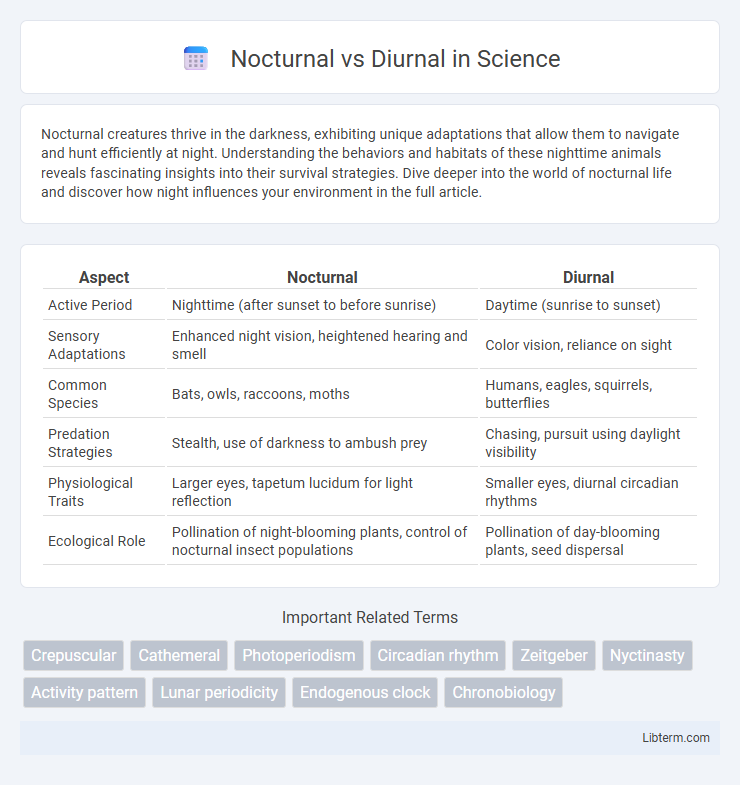Nocturnal creatures thrive in the darkness, exhibiting unique adaptations that allow them to navigate and hunt efficiently at night. Understanding the behaviors and habitats of these nighttime animals reveals fascinating insights into their survival strategies. Dive deeper into the world of nocturnal life and discover how night influences your environment in the full article.
Table of Comparison
| Aspect | Nocturnal | Diurnal |
|---|---|---|
| Active Period | Nighttime (after sunset to before sunrise) | Daytime (sunrise to sunset) |
| Sensory Adaptations | Enhanced night vision, heightened hearing and smell | Color vision, reliance on sight |
| Common Species | Bats, owls, raccoons, moths | Humans, eagles, squirrels, butterflies |
| Predation Strategies | Stealth, use of darkness to ambush prey | Chasing, pursuit using daylight visibility |
| Physiological Traits | Larger eyes, tapetum lucidum for light reflection | Smaller eyes, diurnal circadian rhythms |
| Ecological Role | Pollination of night-blooming plants, control of nocturnal insect populations | Pollination of day-blooming plants, seed dispersal |
Understanding Nocturnal and Diurnal Behaviors
Nocturnal animals exhibit activity patterns primarily during the night, driven by adaptations such as enhanced night vision and heightened senses like hearing and smell to navigate darkness. Diurnal species are active during daylight hours, relying on vision optimized for bright conditions and behaviors synchronized with the sun's cycle for feeding and social interactions. Understanding nocturnal and diurnal behaviors involves examining circadian rhythms, sensory adaptations, and ecological niches that influence survival and reproduction strategies.
Evolutionary Reasons Behind Activity Patterns
Nocturnal and diurnal activity patterns evolved primarily due to ecological pressures such as predation risk, resource availability, and competition. Species adapted to nocturnal behavior avoid daytime predators and exploit nighttime food sources, while diurnal animals benefit from daylight-driven activities like foraging and mating. Evolutionary shifts in vision, sensory organs, and metabolism underline these activity cycles, optimizing survival and reproductive success in specific environmental niches.
Key Differences: Nocturnal vs Diurnal Species
Nocturnal species are active primarily during the night and possess adaptations such as enhanced night vision and heightened olfactory senses to navigate and hunt in darkness. Diurnal species, on the other hand, operate mainly during daylight hours, exhibiting traits like color vision and reliance on visual cues for feeding and mating. These key behavioral and sensory adaptations distinguish nocturnal and diurnal species in their ecological niches and survival strategies.
Adaptations for Night and Day Activity
Nocturnal animals possess adaptations such as enhanced night vision, with a high density of rod cells in their retinas, and acute hearing to navigate and hunt in low-light conditions. Diurnal species adapt through color vision optimized for daylight and higher cone cell concentration, supporting tasks like foraging and predator detection during the day. Both groups exhibit specialized behaviors and physiological traits that maximize their efficiency according to their active periods, including variations in body temperature regulation and sensory reliance.
Examples of Nocturnal Animals
Nocturnal animals such as owls, bats, and raccoons exhibit activity patterns primarily during nighttime, adapted for hunting or foraging under low light conditions. These species possess specialized features like enhanced night vision, acute hearing, and echolocation to navigate and detect prey in darkness. Contrastingly, diurnal animals such as eagles, squirrels, and most primates are active during daylight hours, relying on visual cues and warmth from the sun.
Examples of Diurnal Animals
Diurnal animals, active during daylight hours, include species such as lions, eagles, and elephants. These animals rely on daylight for hunting, foraging, and social interactions, which enhances their ability to find food and avoid predators. Birds like sparrows and mammals like squirrels exemplify diurnal behavior by utilizing daytime for feeding and navigation.
Impact on Ecosystems and Food Webs
Nocturnal and diurnal species shape ecosystems by creating distinct activity patterns that influence feeding behavior, predator-prey interactions, and resource competition. Nocturnal animals often exploit cooler temperatures and reduced predation risk, affecting nighttime food webs, while diurnal species dominate daylight hours, driving daytime ecological processes. This temporal partitioning enhances biodiversity and stabilizes ecosystems by minimizing overlap and promoting balanced energy flow within food webs.
Human Influence on Nocturnal and Diurnal Species
Human activities such as urbanization, artificial lighting, and habitat destruction significantly disrupt the natural behavior of nocturnal and diurnal species, leading to altered feeding, mating, and migration patterns. Light pollution particularly affects nocturnal animals by interfering with their navigation and predation, while daytime noise and habitat fragmentation impact diurnal species' ability to communicate and forage efficiently. Conservation efforts increasingly target mitigating human influence to preserve the ecological balance between nocturnal and diurnal wildlife.
Health Implications for Humans: Night Owls vs Early Birds
Night owls experience higher risks of metabolic disorders, cardiovascular diseases, and mental health issues due to misalignment with societal schedules and circadian rhythms. Early birds tend to have better sleep quality, improved mental well-being, and lower incidence of chronic illnesses linked to consistent sleep patterns and morning light exposure. Chronotype-specific interventions, such as tailored sleep hygiene and exposure to natural light, can mitigate health risks associated with nocturnal or diurnal preferences.
Future Research and Conservation Challenges
Future research on nocturnal and diurnal species must prioritize technological advancements in tracking and monitoring to better understand their behavioral adaptations and habitat use patterns. Conservation challenges include mitigating the impacts of artificial light pollution, which disrupts circadian rhythms, and addressing climate change effects that alter species activity cycles and ecosystem dynamics. Integrating ecological data with genetic and physiological studies will enhance targeted conservation strategies for preserving biodiversity across temporal niches.
Nocturnal Infographic

 libterm.com
libterm.com